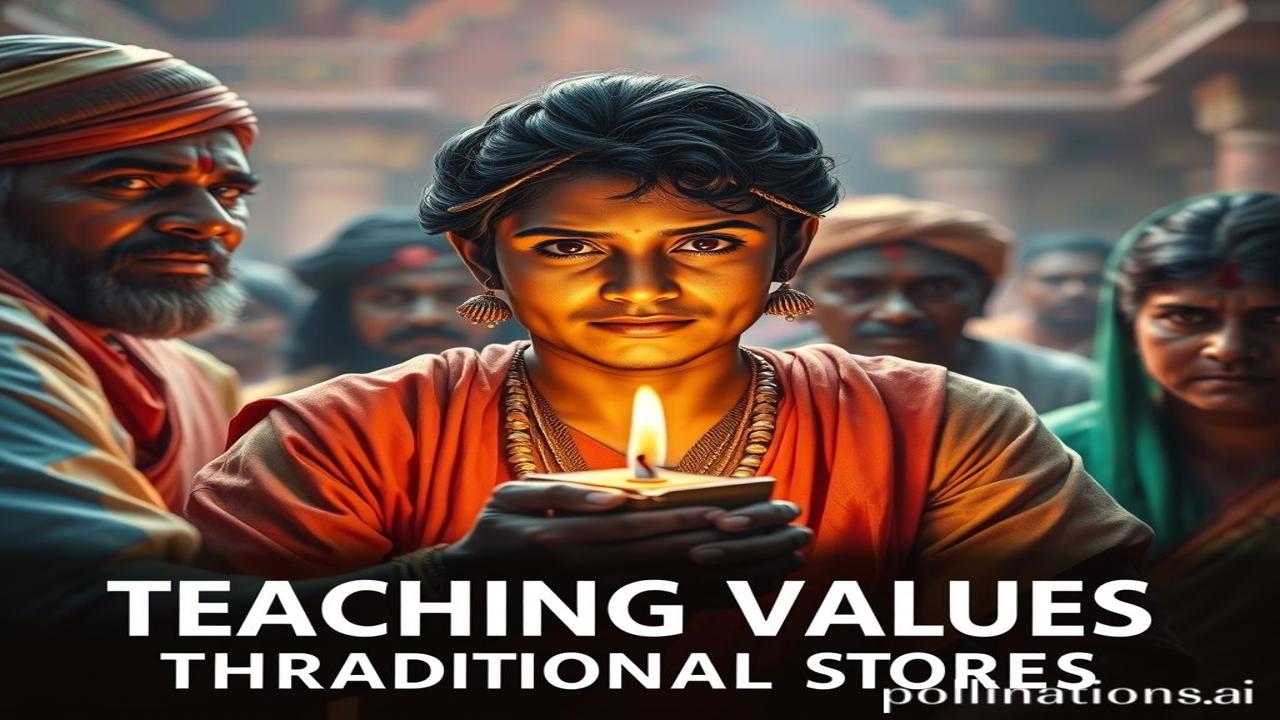Waqt Ki Dhool Mein Chhupi Neeti: Teaching Values Through Traditional Stories
Kabhi socha hai, jab bijli nahi thi, internet nahi tha, tab bachchon ko values kaise sikhate the? Jab grandfather ya grandmother apne charpai pe baith kar, aag ki roshni mein, kahaniyon ka pitara kholte the… woh kahaniyan sirf entertainment nahi thi, woh zindagi ka sabak thi. Woh kahaniyan aaj bhi humare dil mein dabi hui hain, ek choti si spark ki tarah, jo humare actions ko guide karti hain. Let’s delve into that forgotten lane and rediscover how traditional stories taught us values.
Itihasik Prasthbhoomi: The Timeless Tapestry of Indian Storytelling
Traditional storytelling, doston, koi nayi cheez nahi hai. It’s woven into the very fabric of our Bharatiya culture. Think about the Panchatantra, dating back to around 3rd century BCE. These animal fables, attributed to Vishnu Sharma, were designed to impart moral lessons to young princes in a fun and engaging way. Before books, before formal education, stories were the primary vehicle for transmitting values from one generation to the next. The Ramayana and the Mahabharata, though epic in scale, are fundamentally stories filled with teachings on dharma, karma, love, sacrifice, and duty. These aren’t just ancient texts; they are living encyclopedias of values. This oral tradition thrived across India, adapted and embellished in different regions, forming a rich tapestry of local tales, folklores, and legends.
Zameeni Sach – Log Aur Jeevan: A Glimpse into the Past
Imagine a village scene, 500 years ago. Shaam ho rahi hai. Women are drawing rangolis outside their mud houses. The smell of woodsmoke and spices fills the air. Bachche, din bhar khelne ke baad, ek ped ke neeche jama ho jaate hain. Dadi Ma, wrinkles radiating from her eyes like sun rays, begins her story.
“Ek raja tha,” she starts, her voice raspy but warm. “Woh bahut shaktishali tha, lekin usme ahankar tha…”. She talks about the consequences of arrogance, the importance of humility, weaving in relatable characters and situations.
“Ma Rukmini ne aaj naye kapde pehne,” Dadi Ma continues another day, perhaps weaving a tale of kindness and compassion, “Kyunki mandir mein utsav tha aur woh gareebon ko daan de rahi thi.” The children listen, captivated. The stories are simple, but the lessons are profound. They learn about honesty from the tale of Harishchandra, bravery from the saga of Rana Pratap, and the importance of family from the story of the Pandavas. These weren’t just bedtime stories; they were lessons etched into their hearts.
Dharohar Aur Pehchan: Echoes in Modern India
Aaj bhi, even in the age of Netflix and Instagram, traditional stories continue to resonate with Bharatiyata. We see their presence in our rituals, our festivals, our art forms. Look at Ramlila during Dussehra – it’s not just a performance; it’s a reaffirmation of the values of good over evil. The stories of Krishna are painted on temple walls, sung in bhajans, and enacted in dance dramas. These narratives shape our understanding of dharma, karma, and moksha. They contribute to our collective identity, reminding us of the rich cultural heritage we inherit. Even cartoons and animated films often draw inspiration from these traditional narratives, subtly instilling values in the younger generation.
Mazedar Tathya Ya Bhram-Bhanjak: The Surprising Truth
Log samajhte hain ki Panchatantra sirf bachchon ke liye hai… lekin asli sach yeh hai ki its stories were originally created to teach governance and statecraft to young princes! The animal characters were metaphors for different types of people and political situations. It was a sophisticated way to impart complex lessons using engaging narratives. Also, while we often associate these stories with a specific author or source, many of them are the result of centuries of oral transmission, evolving and adapting with each retelling.
Drishya Aur Bhavnaen: A Sensory Experience
Imagine the warmth of the fire crackling in the darkness. The smell of incense wafting from a nearby temple. The rhythmic chanting of mantras echoing in the air. The rough texture of the mat you’re sitting on. These sensory details helped create a powerful and immersive experience for the listener, making the stories more memorable and impactful. The air felt thick with anticipation, the story unfolding slowly, each word carefully chosen, each pause deliberately placed. It wasn’t just about hearing a story; it was about experiencing it, feeling it, living it.
Antim Vichar Ya Uddharan: A Final Reflection
Stories are not just entertainment; they are vessels of wisdom. They are the invisible threads that connect us to our past, shaping our present, and guiding our future. As they say:
“श्रद्धावान् लभते ज्ञानम्” (Shraddhavan labhate jnanam) – “The one who has faith gains knowledge.” Let us keep the faith in the power of our traditional stories to guide us towards a more virtuous and meaningful life. These stories are not just about the past, they are about who we are and who we aspire to be. And that, my friends, is a legacy worth preserving.
